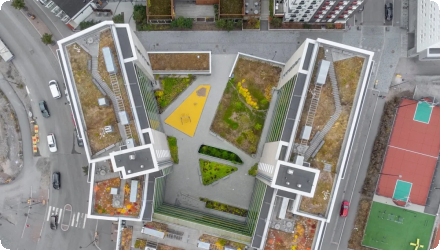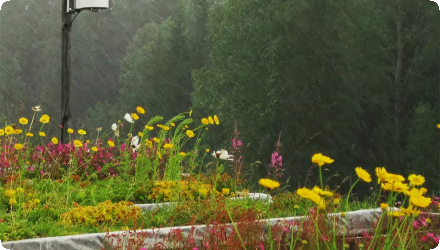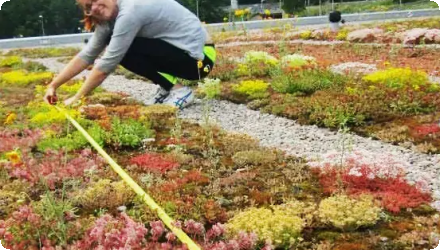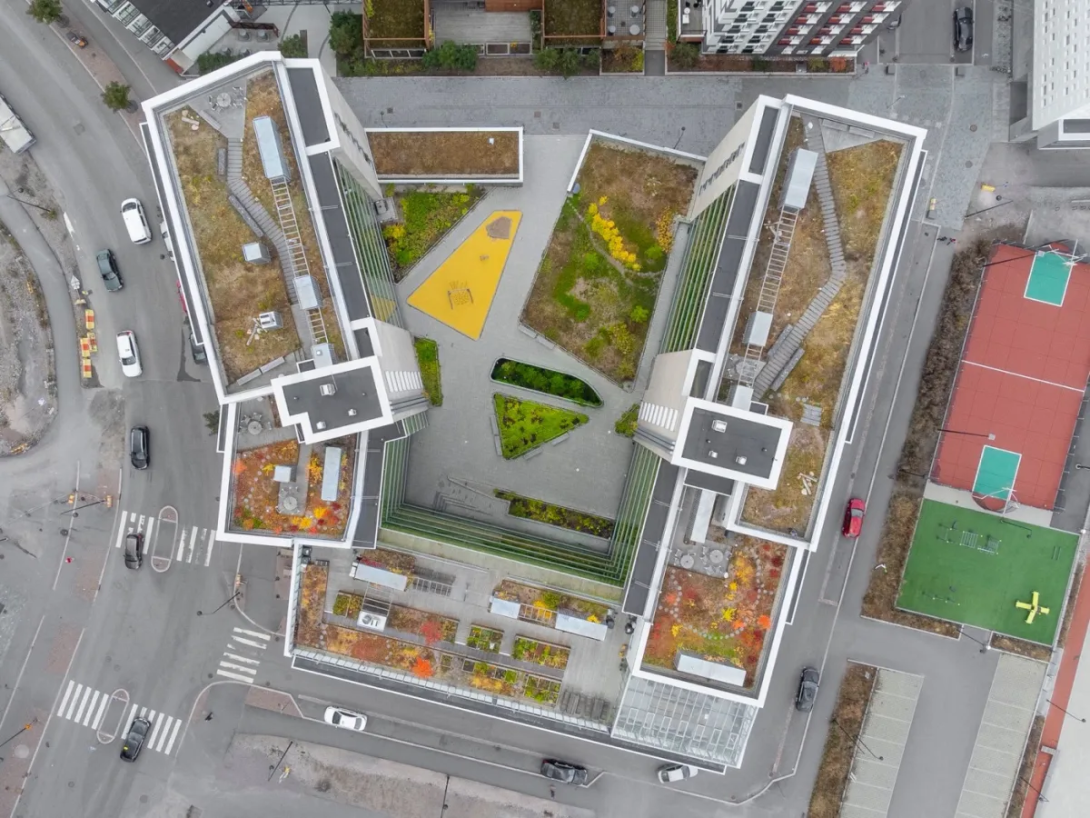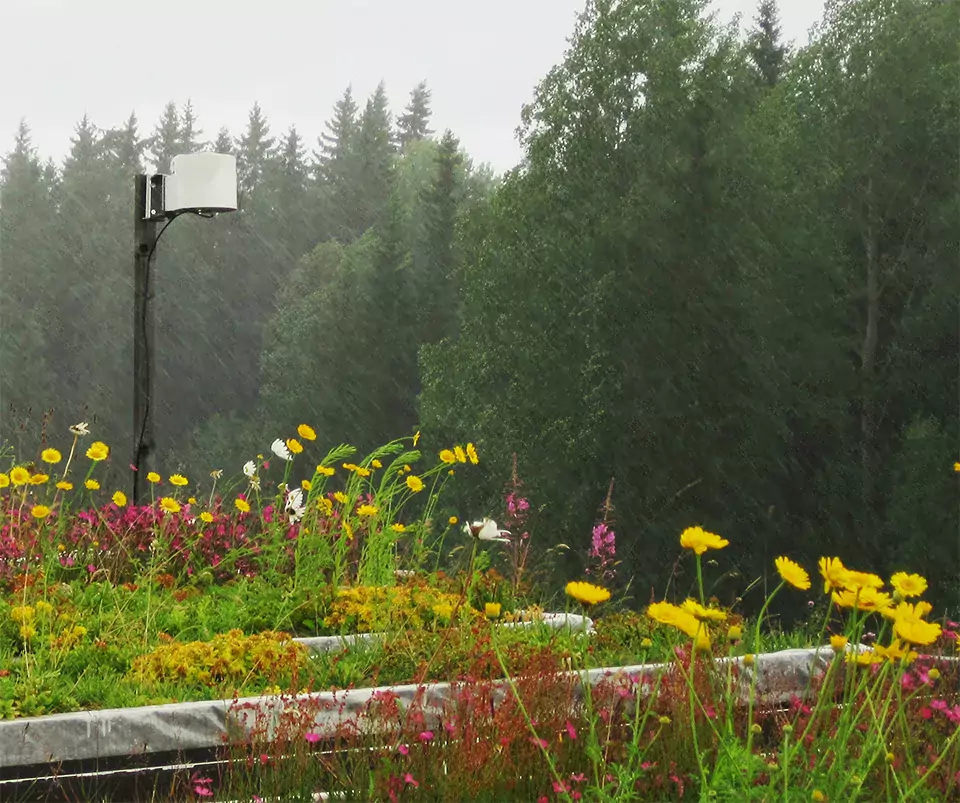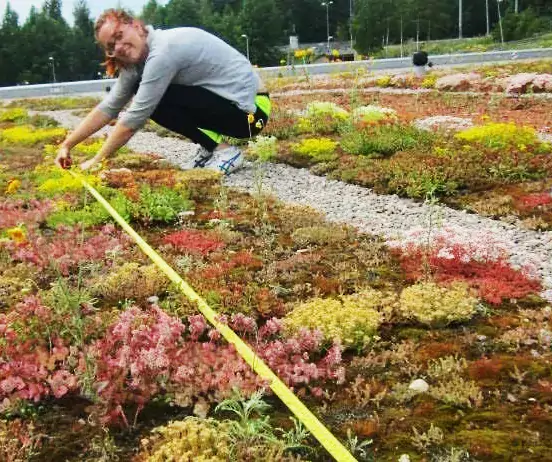Last update
2025
Summary
A series of experiments, created by the University of Helsinki’s Fifth Dimension – Green Roofs in Urban Areas research programme. The green roofs are constructed in nine towns across Finland. The aim is to study green roofs from the perspectives of biodiversity and ecological, social and economic sustainability. A special cost–benefit case study was carried out for Helsinki in 2013. Since then, Helsinki has mainstreamed green roofs in policy and planning: the City’s Green Roof Policy (approved 19 Dec 2016) and a plot-specific Green Factor tool guide zoning and permits; citywide target levels entered into force on 1 Feb 2024 (excluding single/two-family plots). Stormwater management programmes further link green roofs to nature-based solutions. Research in the Helsinki region shows that substrate depth and roof age are key drivers of vegetation; meadow roofs retain and delay runoff in cold climates; vegetated roofs support biodiversity (incl. arthropods and rare snails); and biochar/substrate innovations are being tested with mixed or context-dependent effects. Recent builds in new districts (e.g., Jätkäsaari) demonstrate large, accessible roofs with social uses and ongoing monitoring.
Position
Latitude
60.28
Longitude
25.0817
Project
NWRM
National Id
Finland_03
Installation date
2012
Implementation Status
RBD code
FIVHA2
Transboundary
0
Photo gallery
Location of the project
The research covers multiple roofs in Helsinki; examples explicitly listed include Kumpula, Vuorikatu, Fabianinkatu, Johannes sports field, Lauttasaari sports field, Hakaniemi and Kaisaniemi. One monitored pilot roof is at Johanneksenkenttä (Merimiehenkatu 2, 00120 Helsinki).
NUTS Code
FI1B - Helsinki-Uusimaa
Project's objectives
Research aims (Fifth Dimension programme): evaluate how vegetated roofs enhance ecosystem services and develop optimal designs for urban conditions (biodiversity, ecological, social, economic sustainability). A Helsinki cost–benefit case study (2013) was a core objective.
Involved Partners
| Authority type | Authority name | Role | Comments |
|---|---|---|---|
Climate zone
cool temperate moist
Temperature
5
Annual rainfall range
600 - 900 mm
Elevation range
0 m
Vegetation class
Predominantly extensive green-roof vegetation: sedum mats and dry-meadow grasses/forbs (dry meadow species were a key experimental focus; installations used pregrown sedum mats and meadow substrates with plug plants/seeding).
Water bodies: Ecological Status
Unknown
Water bodies: Chemical Status
Unknown
Project scale
Micro
Project scale specification
This case concerns specific building-level green roofs (experimental installations) in the Helsinki metropolitan area (site listed as Vantaa, NUTS: Helsinki-Uusimaa). Monitoring and research are conducted at roof/plot scale; while the programme spans multiple Finnish towns, the NWRM case itself documents site-level roofs, not a whole basin or region.
Performance timescale
1 - 4 years
Project area
0.18
Area subject to Land use change or Management/Practice change (ha)
0.018
Size
1800
Size unit
m2
Lifespan
40
it is important how many and what kinfd of layers are selected for green roofs
The cases tudy is a part of the Fifth Dimension – Green Roofs in Urban Areas -research program of Finland aiming at finding out the best solutions and practices for sustainable green roofs, which is hard to achieve without combining expertise from different fields
Total cost
unknown
Costs total information
Without operational costs. Cost estimates from Finland are very high in comparison with estimates in particular in those countries with established green roof industries. Estimates for (additional) average green roof costs in Germany range from 13 €/m2 to 41 €/m2.
Costs investment information
The standard bitumen roof costs are around 35 €/m2 (+VAT 24%, = 43 €/m2 ). This includes rubber bitumen layers, waterproofing and installation costs. These installations are needed also under green roofs (with some modifications, the costs remain approximately the same). The additional costs to install a green roof are on average around 50 €/m2 (+VAT 24 %, = 62 €/m2 ). The additional costs include the sedum mats (around 53% of the additional costs), the additional installation costs (around 24% of the additional costs) and additional taxes (23%). Some studies suggest that a new industrial building could require up to 45% increase in building structural costs in order to accommodate a green roof with a design load of 125 kg/m3 .
Financing authorities
Type of funding
Sub-national funds
Type of funding
Sub-national funds
Type of funding
Local funds
Type of funding
Local funds
Type of funding
Private funds
Type of funding
Private funds
Type of funding
Private funds
Compensations
0
Policy context
In the wider metropolitan policy, Helsinki’s Storm Water Management Program (2018) frames the problems as: densification increasing impervious area → more surface runoff and flooding risk; climate change → heavier rains; stormwater often contaminated (traffic, construction materials, energy production, nutrients from managed green areas). Priority is to treat/retain at source and improve quality. Green/vegetated systems are promoted.
Land ownership
The programme’s monitored roofs are on different owners’ buildings: e.g., the Exactum roof on the University of Helsinki’s Kumpula campus, and a pilot roof at Johanneksenkenttä (a municipal sports facility operated by the City of Helsinki).
Community involvment
No
Design consultation activity
| Activity stage | Name | Key issues | Comments |
|---|
Policy target
| Target purpose |
|---|
|
Runoff control
|
|
Peak-flow reduction
|
|
Improved Biodiversity
|
|
Oher Societal Benefits
|
|
Oher Societal Benefits
|
|
Oher Societal Benefits
|
|
Increase Water Storage
|
Target Remarks
green roofs are installed due to several reasons: to increase lifespan of the roof, to save energy by to increased isolation and cooling, to improve storm-water management, to get better air-quality and sound insulation especially in the air craft noise zones.
Policy pressure
| Pressure directive | Relevant pressure |
|---|
Policy impact
| Impact directive | Relevant impact |
|---|
Requirement directive
| Requirement directive | Specification |
|---|
Contractual arrangements
0
| Arrangement type | Responsibility | Role | Name | Comments |
|---|
Part of wider plan
1
Wider plan type
| Wider plan type | Wider plan focus | Name | Comments |
|---|---|---|---|
|
Local
|
Water
|
The roof is part of the stormwater management program of the city of Vantaa.
|
Monitoring is carried out by the University of Helsinki’s Fifth Dimension programme at edge-of-plot scale, focusing on runoff quality and biodiversity indicators, with the city tracking policy-level implementation and upkeep.
It is experimental research project on benefits from green roof , for example, run-off water quality, pollinating insects, the survival of Finnish declining drymeadow species on different kinds of substrates. ect.
Maintenance
No project-specific maintenance regimen is reported for the NWRM Helsinki/Vantaa research roofs
Edge of Field/Plot
no information
Calculations of green roofs provided ecosystem services in Helsinki in 40 years: Membrane longevity 24 €/m2, Sound insulation 0-20 €/m2, Energy savings - cooling 1.9 €/m2 -8.5 €/m2, heating 3.3 €/m2 -24 €/m2, Air-quality benefits (average benefits in Helsinki) 4.8 €/m2 -6.9 €/m2, Storm-water management (average benefits in Helsinki) 1.9 €/m2 -3.4 €/m2.
Stormwater (citywide scenarios). If 50% of roofs were greened, aggregated stormwater benefits were €31–57 million; 10% greening gives €5–11 million. Averaged to ~€1.9–3.4 per m² (present value).
Stormwater (citywide scenarios). If 50% of roofs were greened, aggregated stormwater benefits were €31–57 million; 10% greening gives €5–11 million. Averaged to ~€1.9–3.4 per m² (present value).
Information on retained water
Green roofs can reduce the demand on sewer system capacity by retaining as much as fifty to seventy percent of annual rainfall precipitation depending on regional climate, and even more importantly, by retaining water during heavy rain events, and slowing down water fluxes from surfaces into the sewer.
Information on runoff reduction
It is quite evident that a single green roof or some scattered roofs here and there have a little or no impact on the storm-water management expenditure. However, storm-water modelling has shown that there are potential benefits for large-scale roof greening projects in urban areas (e.g. Obernhorfer et al., 2007; Rosenzweig et al., 2006 and Deutsch et al., 2006). A 10% green roof scenario is estimated to reduce the total annual runoff by 2-3% and 50% green roof scenario by more than 10% when the installed green roofs are lightweight, thin and planted with sedums.
Information on Water quality overall improvements
In Nordic winter, green roofs reduced roof temperature fluctuations; greater frost depth through the green roof yielded higher equivalent thermal resistance. Snow cover acted as an insulator, dampening energy-saving benefits during those periods.
Soil quality overall soil improvements
Not relevant for this application
1
Plants (51 roofs, Helsinki metro): 230 plant species recorded (7 red-listed). Substrate depth and roof age strongly structured communities: thin/young → sedum–moss; thicker/older → meadow species.
Arthropods (17 roofs, Helsinki): vegetated roofs support mobile open-habitat arthropods; roof height (up to 11 m) and litter cover increased abundance, while high grass cover often reduced it; communities differed between succulent vs meadow roofs. One true bug species was new to Finland (arrived with planted materials).
Gastropods (downtown Helsinki roof): four snail species found, incl. two rare in Finland (Pseudotrichia rubiginosa, Succinella oblonga).
Arthropods (17 roofs, Helsinki): vegetated roofs support mobile open-habitat arthropods; roof height (up to 11 m) and litter cover increased abundance, while high grass cover often reduced it; communities differed between succulent vs meadow roofs. One true bug species was new to Finland (arrived with planted materials).
Gastropods (downtown Helsinki roof): four snail species found, incl. two rare in Finland (Pseudotrichia rubiginosa, Succinella oblonga).
Information on Ecosystem impact climate regulation
Energy savings are expected by heating and cooling the property
Ecosystem provisioning services
1
Information on Ecosystem provisioning services
It is possible to grow also vegetables on a green roof
Key lessons
Project surveys are still ongoing, but first results are showing, that green roofs have potential to provide several ecosystem services in metropolitan area of Helsinki, for example, retention of storm water, improvement of air quality, energy savings ect.
Since the case was created, Helsinki has institutionalised green roofs: the City adopted a Green Roof Policy and updated its Storm Water Management Program to prioritise source control; a Green Factor was later integrated into building regulation to steer plot-level greenery (including roofs). Lesson: policy frameworks and design tools matter for uptake and consistency.
Design lessons from the research roofs are clear: substrate depth and roof age strongly shape vegetation outcomes—thin/young roofs favour sedum–moss, thicker/older roofs support meadow communities. Hydrologically, meadow roofs in the Helsinki region retain about 40–70% of annual rainfall (≈80% in summer; 30–40% in winter) and attenuate peaks, even with freezing conditions.
There are important water-quality caveats. Newly installed green roofs can leach nutrients (notably P and N). Biochar amendments can reduce cumulative leaching, but effects vary by material and setup, so selection and testing are essential to avoid unintended consequences.
Biodiversity responses are tangible at roof scale. Surveys across 51 roofs recorded 230 plant species (including red-listed taxa); arthropod studies show open-habitat communities persist on roofs; rare snails have even been documented on central Helsinki rooftops. Lesson: with suitable substrates and management, roofs can function as complementary urban habitats.
Economically, Helsinki’s cost–benefit work finds private payback is often weak, while social benefits (stormwater, air quality, amenity, noise) tip the balance positive—implying that incentives or requirements are justified to align private and public interests.
Finally, demonstration blocks with accessible roofs indicate social co-benefits—gardening, learning, and community use—when design intentionally invites people onto roofs.
Since the case was created, Helsinki has institutionalised green roofs: the City adopted a Green Roof Policy and updated its Storm Water Management Program to prioritise source control; a Green Factor was later integrated into building regulation to steer plot-level greenery (including roofs). Lesson: policy frameworks and design tools matter for uptake and consistency.
Design lessons from the research roofs are clear: substrate depth and roof age strongly shape vegetation outcomes—thin/young roofs favour sedum–moss, thicker/older roofs support meadow communities. Hydrologically, meadow roofs in the Helsinki region retain about 40–70% of annual rainfall (≈80% in summer; 30–40% in winter) and attenuate peaks, even with freezing conditions.
There are important water-quality caveats. Newly installed green roofs can leach nutrients (notably P and N). Biochar amendments can reduce cumulative leaching, but effects vary by material and setup, so selection and testing are essential to avoid unintended consequences.
Biodiversity responses are tangible at roof scale. Surveys across 51 roofs recorded 230 plant species (including red-listed taxa); arthropod studies show open-habitat communities persist on roofs; rare snails have even been documented on central Helsinki rooftops. Lesson: with suitable substrates and management, roofs can function as complementary urban habitats.
Economically, Helsinki’s cost–benefit work finds private payback is often weak, while social benefits (stormwater, air quality, amenity, noise) tip the balance positive—implying that incentives or requirements are justified to align private and public interests.
Finally, demonstration blocks with accessible roofs indicate social co-benefits—gardening, learning, and community use—when design intentionally invites people onto roofs.
Success factor(s)
| Success factor type | Success factor role | Comments | Order |
|---|---|---|---|
|
Other
|
main factor
|
<p>no information</p>
|
1
|
Driver
| Driver type | Driver role | Comments | Order |
|---|---|---|---|
|
Other
|
main driver
|
Improvement of the living environment in cities
|
1
|
Transferability
Highly transferable if tailored to context. Helsinki shows viability in cold climates, but outcomes hinge on substrate depth/age and careful design. Watch for early nutrient leaching; test substrates/biochar and protect drains. Private payback is often weak—policy tools (e.g., Green Factor) aid uptake. Align with local stormwater targets and monitor seasonally.
Cost effectiveness
when public benefits (stormwater, air quality, amenity, longer roof life) are counted, benefits exceed costs; privately, payback is often weak without incentives. Additional capex ≈ €50/m² over standard roofs.
English
